Innovation and Technology Management Report: Start-up Growth
VerifiedAdded on 2020/02/24
|15
|3969
|72
Report
AI Summary
This report delves into the multifaceted dimensions of innovation and its critical role in fostering the growth of small start-up entrepreneurs. It examines international trends in innovation and technology, exploring their relationship with international business. The analysis includes a review of normative questions related to technology, people, and the marketplace in the 21st century, along with an evaluation of the significance of innovation and associated strategic issues. The report emphasizes the importance of process innovation for customers and end-users, assessing the contingency factors that influence process choices. It covers various types of innovation such as radical and incremental. The report also examines how innovation can be implemented in the organization in order to accelerate growth and development such as product, process, paradigm and position. The report emphasizes the importance of process innovation for customers and end-users, assessing the contingency factors that influence process choices and providing case studies of companies like Zara and Samsung that have successfully implemented innovation strategies. The report also discusses the challenges and factors influencing innovation, including internal and external factors like leadership style, corporate culture, and access to finance.
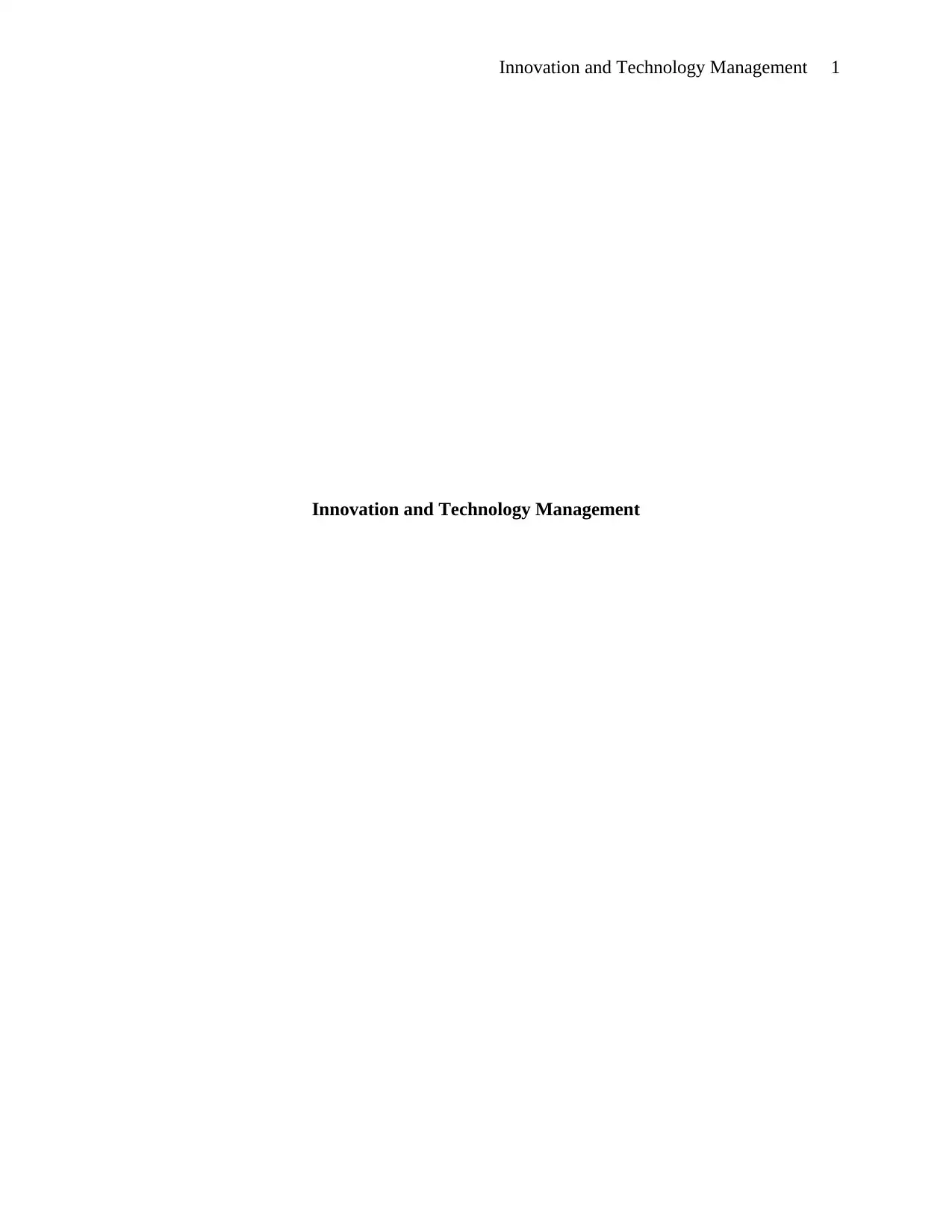
Innovation and Technology Management 1
Innovation and Technology Management
Innovation and Technology Management
Paraphrase This Document
Need a fresh take? Get an instant paraphrase of this document with our AI Paraphraser
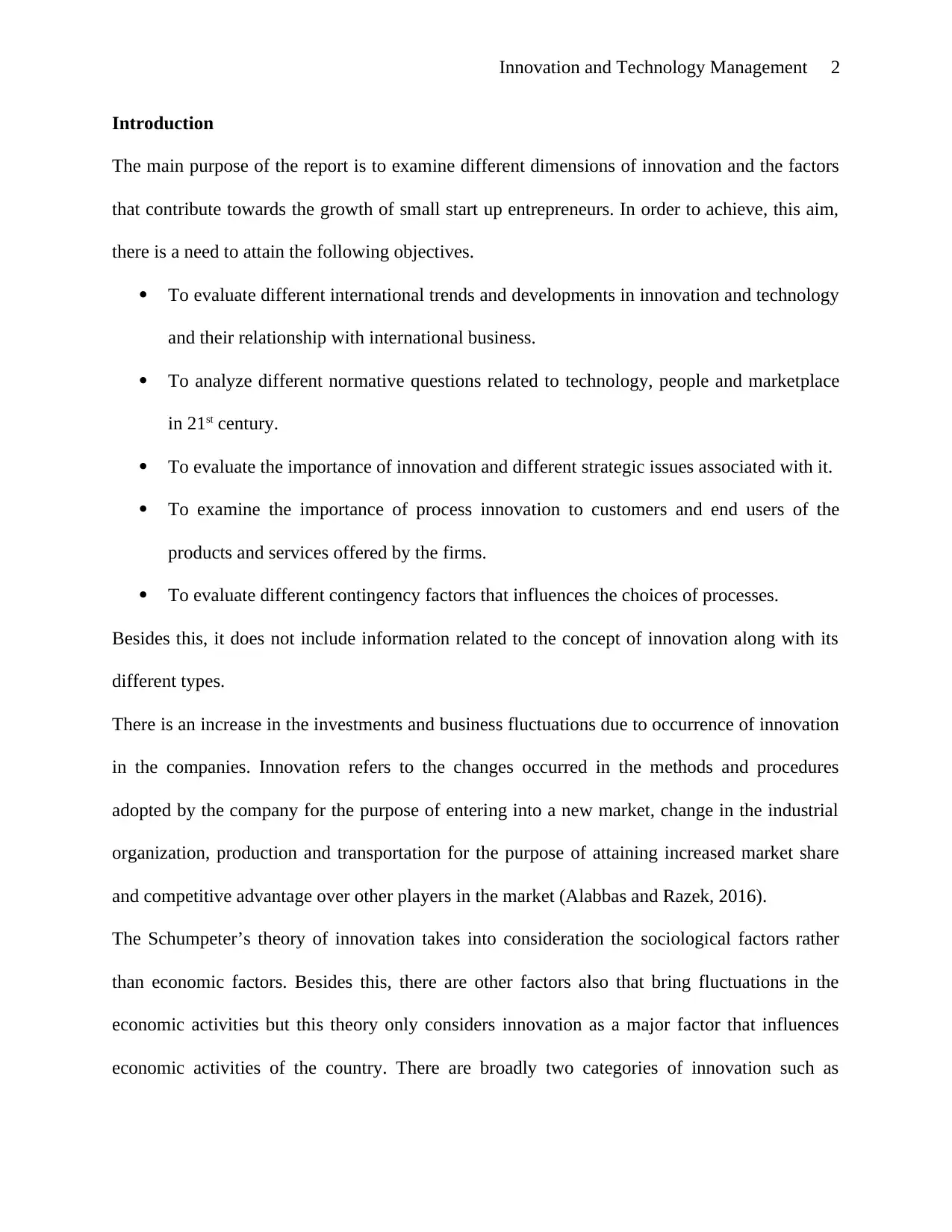
Innovation and Technology Management 2
Introduction
The main purpose of the report is to examine different dimensions of innovation and the factors
that contribute towards the growth of small start up entrepreneurs. In order to achieve, this aim,
there is a need to attain the following objectives.
To evaluate different international trends and developments in innovation and technology
and their relationship with international business.
To analyze different normative questions related to technology, people and marketplace
in 21st century.
To evaluate the importance of innovation and different strategic issues associated with it.
To examine the importance of process innovation to customers and end users of the
products and services offered by the firms.
To evaluate different contingency factors that influences the choices of processes.
Besides this, it does not include information related to the concept of innovation along with its
different types.
There is an increase in the investments and business fluctuations due to occurrence of innovation
in the companies. Innovation refers to the changes occurred in the methods and procedures
adopted by the company for the purpose of entering into a new market, change in the industrial
organization, production and transportation for the purpose of attaining increased market share
and competitive advantage over other players in the market (Alabbas and Razek, 2016).
The Schumpeter’s theory of innovation takes into consideration the sociological factors rather
than economic factors. Besides this, there are other factors also that bring fluctuations in the
economic activities but this theory only considers innovation as a major factor that influences
economic activities of the country. There are broadly two categories of innovation such as
Introduction
The main purpose of the report is to examine different dimensions of innovation and the factors
that contribute towards the growth of small start up entrepreneurs. In order to achieve, this aim,
there is a need to attain the following objectives.
To evaluate different international trends and developments in innovation and technology
and their relationship with international business.
To analyze different normative questions related to technology, people and marketplace
in 21st century.
To evaluate the importance of innovation and different strategic issues associated with it.
To examine the importance of process innovation to customers and end users of the
products and services offered by the firms.
To evaluate different contingency factors that influences the choices of processes.
Besides this, it does not include information related to the concept of innovation along with its
different types.
There is an increase in the investments and business fluctuations due to occurrence of innovation
in the companies. Innovation refers to the changes occurred in the methods and procedures
adopted by the company for the purpose of entering into a new market, change in the industrial
organization, production and transportation for the purpose of attaining increased market share
and competitive advantage over other players in the market (Alabbas and Razek, 2016).
The Schumpeter’s theory of innovation takes into consideration the sociological factors rather
than economic factors. Besides this, there are other factors also that bring fluctuations in the
economic activities but this theory only considers innovation as a major factor that influences
economic activities of the country. There are broadly two categories of innovation such as

Innovation and Technology Management 3
radical innovation and incremental innovation. There are mainly four dimensions in which the
innovation will take place in the organization in order to accelerate growth and development
such as product, process, paradigm and position (Matthews and Brueggemann, 2015).
Literature Review
Significance and dimensions of innovation
In the views of Morris (2013), nowadays, businesses focuses on implementing innovation in
order to attain competitive advantage over other players in the market in terms of product mix,
customer relationships, location, size and technology. Bringing innovation in different elements
helps in the maintenance and development of existing and new advantages of the businesses.
Innovation in a company takes place in two manners namely continuous and discontinuous.
Continuous innovation facilitates in keeping pace with the changes bring by its competitors.
Along with this, discontinuous innovation helps in differentiating the portfolio of the companies
from that of other companies. Innovation is considered as a only source for achieving sustainable
competitive advantage.
As per the views of Alabbas and Razek (2016), the dimensions of innovation is classified in two
categories namely one dimensional innovation type and multidimensional innovation type. On
the basis of one dimensional innovation type, the innovation can be done in process, product,
paradigm and position. The product innovation occurs when there is an occurrence of changes in
the performance capabilities, improvement in characteristics of products in a way of adding and
modifying the features offered in the existing products. The process innovation takes place when
a company adopts new technology in terms of new machines and changes in the production
methods to offer existing products to its customers. The position innovation takes place when a
radical innovation and incremental innovation. There are mainly four dimensions in which the
innovation will take place in the organization in order to accelerate growth and development
such as product, process, paradigm and position (Matthews and Brueggemann, 2015).
Literature Review
Significance and dimensions of innovation
In the views of Morris (2013), nowadays, businesses focuses on implementing innovation in
order to attain competitive advantage over other players in the market in terms of product mix,
customer relationships, location, size and technology. Bringing innovation in different elements
helps in the maintenance and development of existing and new advantages of the businesses.
Innovation in a company takes place in two manners namely continuous and discontinuous.
Continuous innovation facilitates in keeping pace with the changes bring by its competitors.
Along with this, discontinuous innovation helps in differentiating the portfolio of the companies
from that of other companies. Innovation is considered as a only source for achieving sustainable
competitive advantage.
As per the views of Alabbas and Razek (2016), the dimensions of innovation is classified in two
categories namely one dimensional innovation type and multidimensional innovation type. On
the basis of one dimensional innovation type, the innovation can be done in process, product,
paradigm and position. The product innovation occurs when there is an occurrence of changes in
the performance capabilities, improvement in characteristics of products in a way of adding and
modifying the features offered in the existing products. The process innovation takes place when
a company adopts new technology in terms of new machines and changes in the production
methods to offer existing products to its customers. The position innovation takes place when a
⊘ This is a preview!⊘
Do you want full access?
Subscribe today to unlock all pages.

Trusted by 1+ million students worldwide
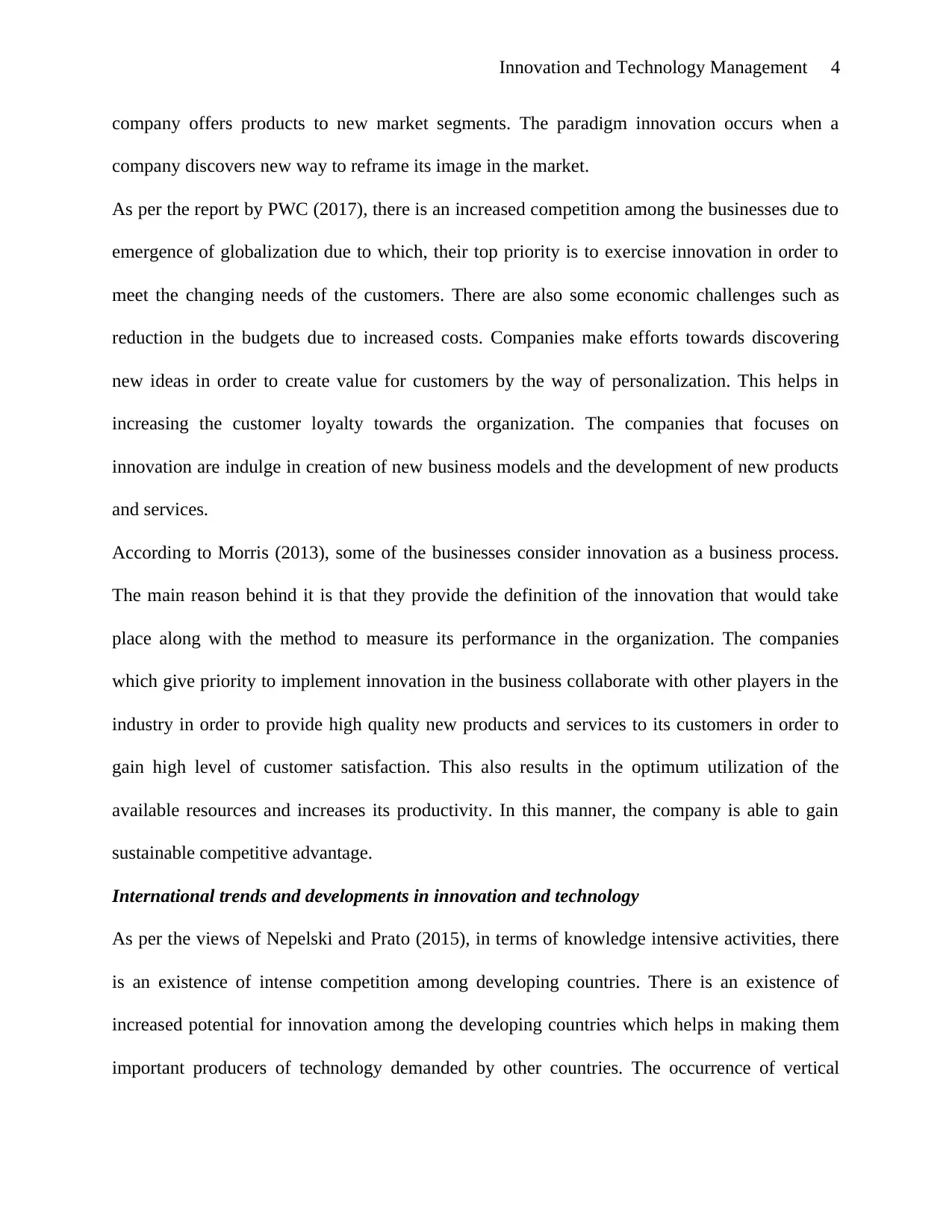
Innovation and Technology Management 4
company offers products to new market segments. The paradigm innovation occurs when a
company discovers new way to reframe its image in the market.
As per the report by PWC (2017), there is an increased competition among the businesses due to
emergence of globalization due to which, their top priority is to exercise innovation in order to
meet the changing needs of the customers. There are also some economic challenges such as
reduction in the budgets due to increased costs. Companies make efforts towards discovering
new ideas in order to create value for customers by the way of personalization. This helps in
increasing the customer loyalty towards the organization. The companies that focuses on
innovation are indulge in creation of new business models and the development of new products
and services.
According to Morris (2013), some of the businesses consider innovation as a business process.
The main reason behind it is that they provide the definition of the innovation that would take
place along with the method to measure its performance in the organization. The companies
which give priority to implement innovation in the business collaborate with other players in the
industry in order to provide high quality new products and services to its customers in order to
gain high level of customer satisfaction. This also results in the optimum utilization of the
available resources and increases its productivity. In this manner, the company is able to gain
sustainable competitive advantage.
International trends and developments in innovation and technology
As per the views of Nepelski and Prato (2015), in terms of knowledge intensive activities, there
is an existence of intense competition among developing countries. There is an existence of
increased potential for innovation among the developing countries which helps in making them
important producers of technology demanded by other countries. The occurrence of vertical
company offers products to new market segments. The paradigm innovation occurs when a
company discovers new way to reframe its image in the market.
As per the report by PWC (2017), there is an increased competition among the businesses due to
emergence of globalization due to which, their top priority is to exercise innovation in order to
meet the changing needs of the customers. There are also some economic challenges such as
reduction in the budgets due to increased costs. Companies make efforts towards discovering
new ideas in order to create value for customers by the way of personalization. This helps in
increasing the customer loyalty towards the organization. The companies that focuses on
innovation are indulge in creation of new business models and the development of new products
and services.
According to Morris (2013), some of the businesses consider innovation as a business process.
The main reason behind it is that they provide the definition of the innovation that would take
place along with the method to measure its performance in the organization. The companies
which give priority to implement innovation in the business collaborate with other players in the
industry in order to provide high quality new products and services to its customers in order to
gain high level of customer satisfaction. This also results in the optimum utilization of the
available resources and increases its productivity. In this manner, the company is able to gain
sustainable competitive advantage.
International trends and developments in innovation and technology
As per the views of Nepelski and Prato (2015), in terms of knowledge intensive activities, there
is an existence of intense competition among developing countries. There is an existence of
increased potential for innovation among the developing countries which helps in making them
important producers of technology demanded by other countries. The occurrence of vertical
Paraphrase This Document
Need a fresh take? Get an instant paraphrase of this document with our AI Paraphraser
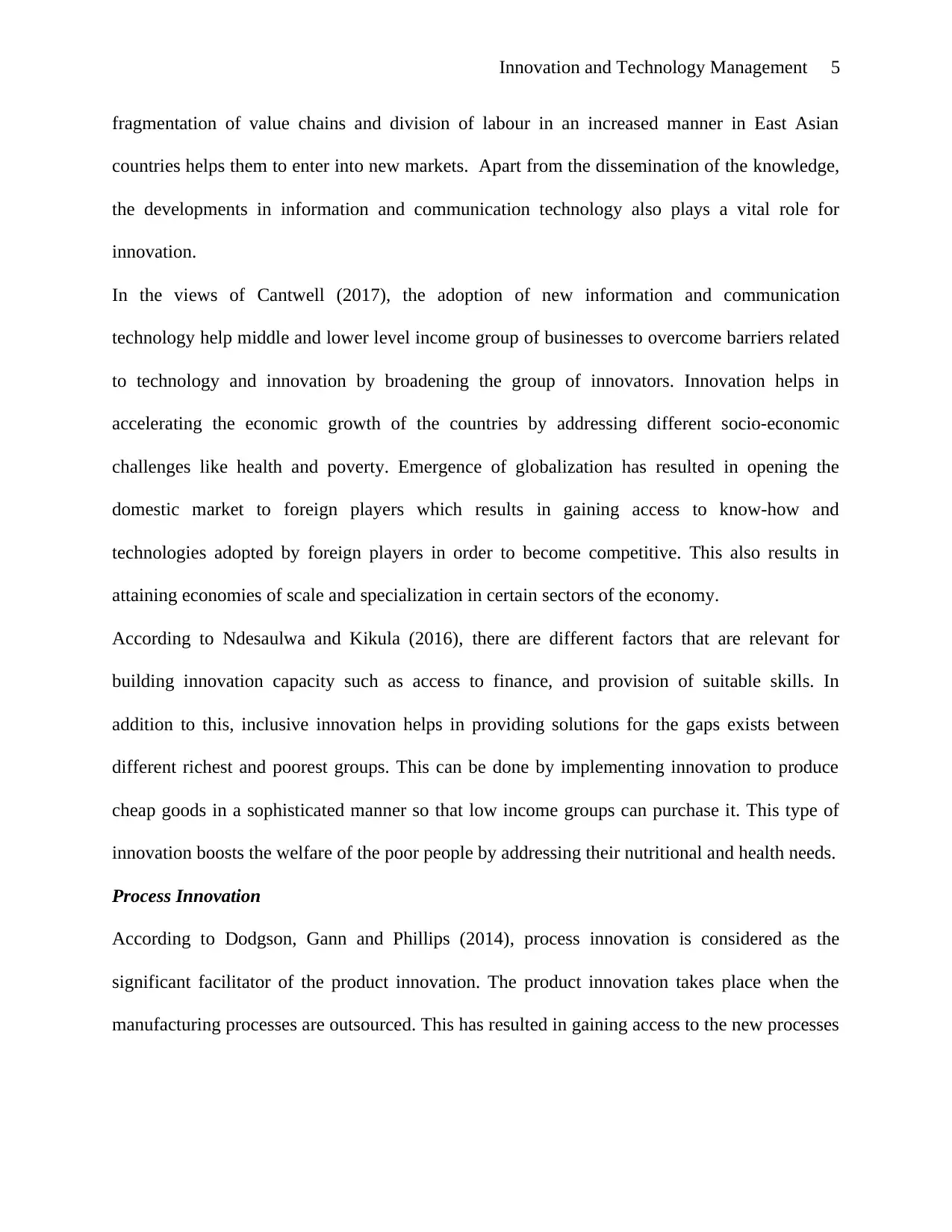
Innovation and Technology Management 5
fragmentation of value chains and division of labour in an increased manner in East Asian
countries helps them to enter into new markets. Apart from the dissemination of the knowledge,
the developments in information and communication technology also plays a vital role for
innovation.
In the views of Cantwell (2017), the adoption of new information and communication
technology help middle and lower level income group of businesses to overcome barriers related
to technology and innovation by broadening the group of innovators. Innovation helps in
accelerating the economic growth of the countries by addressing different socio-economic
challenges like health and poverty. Emergence of globalization has resulted in opening the
domestic market to foreign players which results in gaining access to know-how and
technologies adopted by foreign players in order to become competitive. This also results in
attaining economies of scale and specialization in certain sectors of the economy.
According to Ndesaulwa and Kikula (2016), there are different factors that are relevant for
building innovation capacity such as access to finance, and provision of suitable skills. In
addition to this, inclusive innovation helps in providing solutions for the gaps exists between
different richest and poorest groups. This can be done by implementing innovation to produce
cheap goods in a sophisticated manner so that low income groups can purchase it. This type of
innovation boosts the welfare of the poor people by addressing their nutritional and health needs.
Process Innovation
According to Dodgson, Gann and Phillips (2014), process innovation is considered as the
significant facilitator of the product innovation. The product innovation takes place when the
manufacturing processes are outsourced. This has resulted in gaining access to the new processes
fragmentation of value chains and division of labour in an increased manner in East Asian
countries helps them to enter into new markets. Apart from the dissemination of the knowledge,
the developments in information and communication technology also plays a vital role for
innovation.
In the views of Cantwell (2017), the adoption of new information and communication
technology help middle and lower level income group of businesses to overcome barriers related
to technology and innovation by broadening the group of innovators. Innovation helps in
accelerating the economic growth of the countries by addressing different socio-economic
challenges like health and poverty. Emergence of globalization has resulted in opening the
domestic market to foreign players which results in gaining access to know-how and
technologies adopted by foreign players in order to become competitive. This also results in
attaining economies of scale and specialization in certain sectors of the economy.
According to Ndesaulwa and Kikula (2016), there are different factors that are relevant for
building innovation capacity such as access to finance, and provision of suitable skills. In
addition to this, inclusive innovation helps in providing solutions for the gaps exists between
different richest and poorest groups. This can be done by implementing innovation to produce
cheap goods in a sophisticated manner so that low income groups can purchase it. This type of
innovation boosts the welfare of the poor people by addressing their nutritional and health needs.
Process Innovation
According to Dodgson, Gann and Phillips (2014), process innovation is considered as the
significant facilitator of the product innovation. The product innovation takes place when the
manufacturing processes are outsourced. This has resulted in gaining access to the new processes
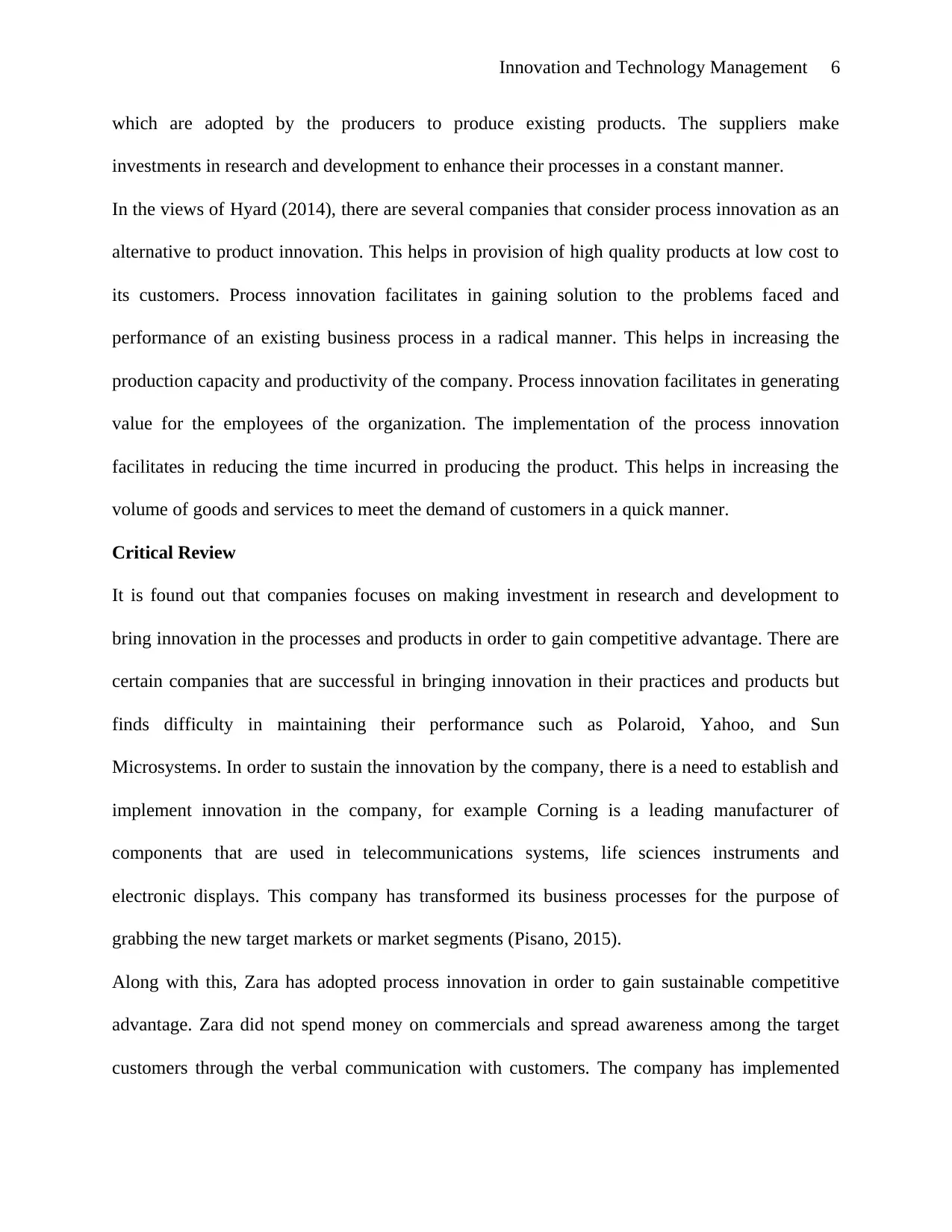
Innovation and Technology Management 6
which are adopted by the producers to produce existing products. The suppliers make
investments in research and development to enhance their processes in a constant manner.
In the views of Hyard (2014), there are several companies that consider process innovation as an
alternative to product innovation. This helps in provision of high quality products at low cost to
its customers. Process innovation facilitates in gaining solution to the problems faced and
performance of an existing business process in a radical manner. This helps in increasing the
production capacity and productivity of the company. Process innovation facilitates in generating
value for the employees of the organization. The implementation of the process innovation
facilitates in reducing the time incurred in producing the product. This helps in increasing the
volume of goods and services to meet the demand of customers in a quick manner.
Critical Review
It is found out that companies focuses on making investment in research and development to
bring innovation in the processes and products in order to gain competitive advantage. There are
certain companies that are successful in bringing innovation in their practices and products but
finds difficulty in maintaining their performance such as Polaroid, Yahoo, and Sun
Microsystems. In order to sustain the innovation by the company, there is a need to establish and
implement innovation in the company, for example Corning is a leading manufacturer of
components that are used in telecommunications systems, life sciences instruments and
electronic displays. This company has transformed its business processes for the purpose of
grabbing the new target markets or market segments (Pisano, 2015).
Along with this, Zara has adopted process innovation in order to gain sustainable competitive
advantage. Zara did not spend money on commercials and spread awareness among the target
customers through the verbal communication with customers. The company has implemented
which are adopted by the producers to produce existing products. The suppliers make
investments in research and development to enhance their processes in a constant manner.
In the views of Hyard (2014), there are several companies that consider process innovation as an
alternative to product innovation. This helps in provision of high quality products at low cost to
its customers. Process innovation facilitates in gaining solution to the problems faced and
performance of an existing business process in a radical manner. This helps in increasing the
production capacity and productivity of the company. Process innovation facilitates in generating
value for the employees of the organization. The implementation of the process innovation
facilitates in reducing the time incurred in producing the product. This helps in increasing the
volume of goods and services to meet the demand of customers in a quick manner.
Critical Review
It is found out that companies focuses on making investment in research and development to
bring innovation in the processes and products in order to gain competitive advantage. There are
certain companies that are successful in bringing innovation in their practices and products but
finds difficulty in maintaining their performance such as Polaroid, Yahoo, and Sun
Microsystems. In order to sustain the innovation by the company, there is a need to establish and
implement innovation in the company, for example Corning is a leading manufacturer of
components that are used in telecommunications systems, life sciences instruments and
electronic displays. This company has transformed its business processes for the purpose of
grabbing the new target markets or market segments (Pisano, 2015).
Along with this, Zara has adopted process innovation in order to gain sustainable competitive
advantage. Zara did not spend money on commercials and spread awareness among the target
customers through the verbal communication with customers. The company has implemented
⊘ This is a preview!⊘
Do you want full access?
Subscribe today to unlock all pages.

Trusted by 1+ million students worldwide
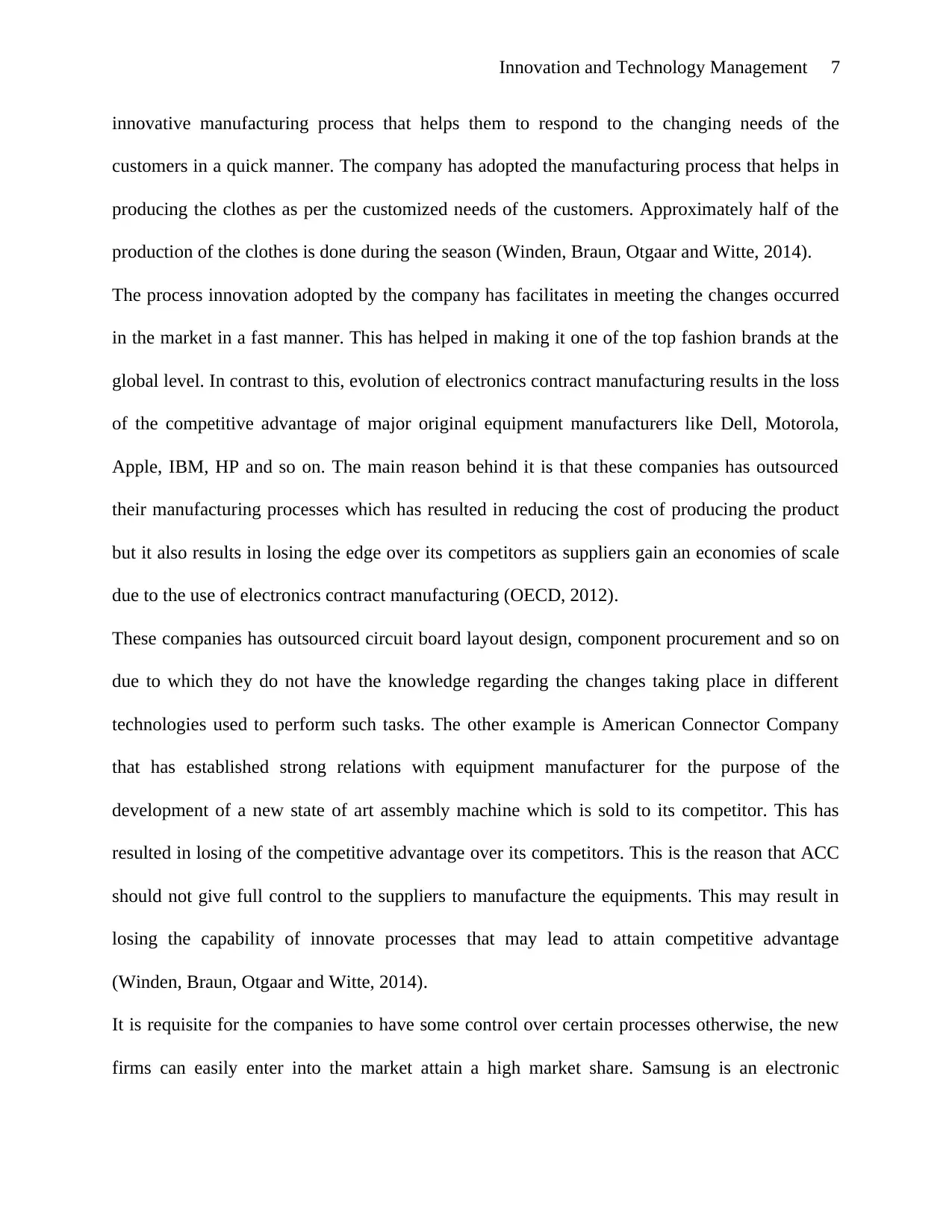
Innovation and Technology Management 7
innovative manufacturing process that helps them to respond to the changing needs of the
customers in a quick manner. The company has adopted the manufacturing process that helps in
producing the clothes as per the customized needs of the customers. Approximately half of the
production of the clothes is done during the season (Winden, Braun, Otgaar and Witte, 2014).
The process innovation adopted by the company has facilitates in meeting the changes occurred
in the market in a fast manner. This has helped in making it one of the top fashion brands at the
global level. In contrast to this, evolution of electronics contract manufacturing results in the loss
of the competitive advantage of major original equipment manufacturers like Dell, Motorola,
Apple, IBM, HP and so on. The main reason behind it is that these companies has outsourced
their manufacturing processes which has resulted in reducing the cost of producing the product
but it also results in losing the edge over its competitors as suppliers gain an economies of scale
due to the use of electronics contract manufacturing (OECD, 2012).
These companies has outsourced circuit board layout design, component procurement and so on
due to which they do not have the knowledge regarding the changes taking place in different
technologies used to perform such tasks. The other example is American Connector Company
that has established strong relations with equipment manufacturer for the purpose of the
development of a new state of art assembly machine which is sold to its competitor. This has
resulted in losing of the competitive advantage over its competitors. This is the reason that ACC
should not give full control to the suppliers to manufacture the equipments. This may result in
losing the capability of innovate processes that may lead to attain competitive advantage
(Winden, Braun, Otgaar and Witte, 2014).
It is requisite for the companies to have some control over certain processes otherwise, the new
firms can easily enter into the market attain a high market share. Samsung is an electronic
innovative manufacturing process that helps them to respond to the changing needs of the
customers in a quick manner. The company has adopted the manufacturing process that helps in
producing the clothes as per the customized needs of the customers. Approximately half of the
production of the clothes is done during the season (Winden, Braun, Otgaar and Witte, 2014).
The process innovation adopted by the company has facilitates in meeting the changes occurred
in the market in a fast manner. This has helped in making it one of the top fashion brands at the
global level. In contrast to this, evolution of electronics contract manufacturing results in the loss
of the competitive advantage of major original equipment manufacturers like Dell, Motorola,
Apple, IBM, HP and so on. The main reason behind it is that these companies has outsourced
their manufacturing processes which has resulted in reducing the cost of producing the product
but it also results in losing the edge over its competitors as suppliers gain an economies of scale
due to the use of electronics contract manufacturing (OECD, 2012).
These companies has outsourced circuit board layout design, component procurement and so on
due to which they do not have the knowledge regarding the changes taking place in different
technologies used to perform such tasks. The other example is American Connector Company
that has established strong relations with equipment manufacturer for the purpose of the
development of a new state of art assembly machine which is sold to its competitor. This has
resulted in losing of the competitive advantage over its competitors. This is the reason that ACC
should not give full control to the suppliers to manufacture the equipments. This may result in
losing the capability of innovate processes that may lead to attain competitive advantage
(Winden, Braun, Otgaar and Witte, 2014).
It is requisite for the companies to have some control over certain processes otherwise, the new
firms can easily enter into the market attain a high market share. Samsung is an electronic
Paraphrase This Document
Need a fresh take? Get an instant paraphrase of this document with our AI Paraphraser
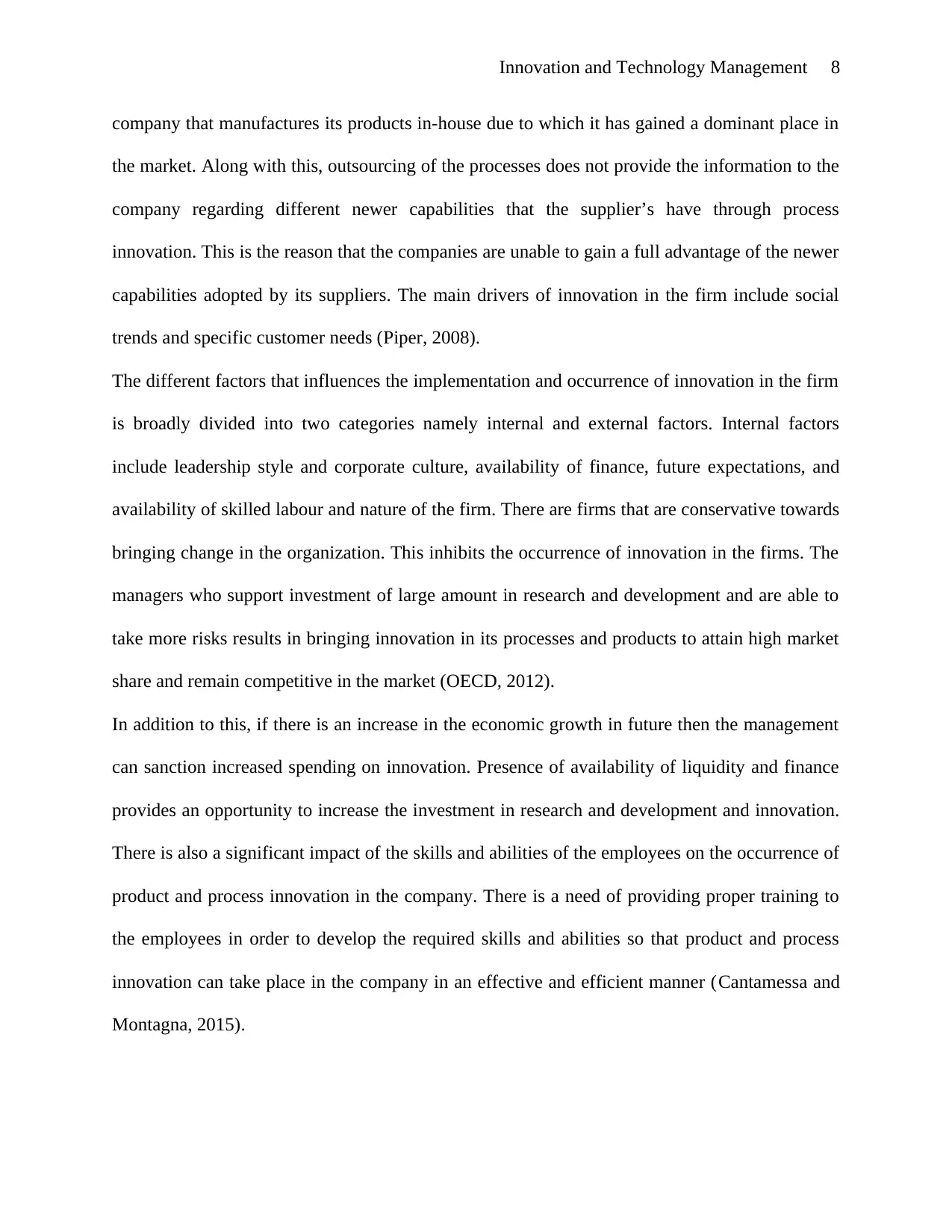
Innovation and Technology Management 8
company that manufactures its products in-house due to which it has gained a dominant place in
the market. Along with this, outsourcing of the processes does not provide the information to the
company regarding different newer capabilities that the supplier’s have through process
innovation. This is the reason that the companies are unable to gain a full advantage of the newer
capabilities adopted by its suppliers. The main drivers of innovation in the firm include social
trends and specific customer needs (Piper, 2008).
The different factors that influences the implementation and occurrence of innovation in the firm
is broadly divided into two categories namely internal and external factors. Internal factors
include leadership style and corporate culture, availability of finance, future expectations, and
availability of skilled labour and nature of the firm. There are firms that are conservative towards
bringing change in the organization. This inhibits the occurrence of innovation in the firms. The
managers who support investment of large amount in research and development and are able to
take more risks results in bringing innovation in its processes and products to attain high market
share and remain competitive in the market (OECD, 2012).
In addition to this, if there is an increase in the economic growth in future then the management
can sanction increased spending on innovation. Presence of availability of liquidity and finance
provides an opportunity to increase the investment in research and development and innovation.
There is also a significant impact of the skills and abilities of the employees on the occurrence of
product and process innovation in the company. There is a need of providing proper training to
the employees in order to develop the required skills and abilities so that product and process
innovation can take place in the company in an effective and efficient manner (Cantamessa and
Montagna, 2015).
company that manufactures its products in-house due to which it has gained a dominant place in
the market. Along with this, outsourcing of the processes does not provide the information to the
company regarding different newer capabilities that the supplier’s have through process
innovation. This is the reason that the companies are unable to gain a full advantage of the newer
capabilities adopted by its suppliers. The main drivers of innovation in the firm include social
trends and specific customer needs (Piper, 2008).
The different factors that influences the implementation and occurrence of innovation in the firm
is broadly divided into two categories namely internal and external factors. Internal factors
include leadership style and corporate culture, availability of finance, future expectations, and
availability of skilled labour and nature of the firm. There are firms that are conservative towards
bringing change in the organization. This inhibits the occurrence of innovation in the firms. The
managers who support investment of large amount in research and development and are able to
take more risks results in bringing innovation in its processes and products to attain high market
share and remain competitive in the market (OECD, 2012).
In addition to this, if there is an increase in the economic growth in future then the management
can sanction increased spending on innovation. Presence of availability of liquidity and finance
provides an opportunity to increase the investment in research and development and innovation.
There is also a significant impact of the skills and abilities of the employees on the occurrence of
product and process innovation in the company. There is a need of providing proper training to
the employees in order to develop the required skills and abilities so that product and process
innovation can take place in the company in an effective and efficient manner (Cantamessa and
Montagna, 2015).
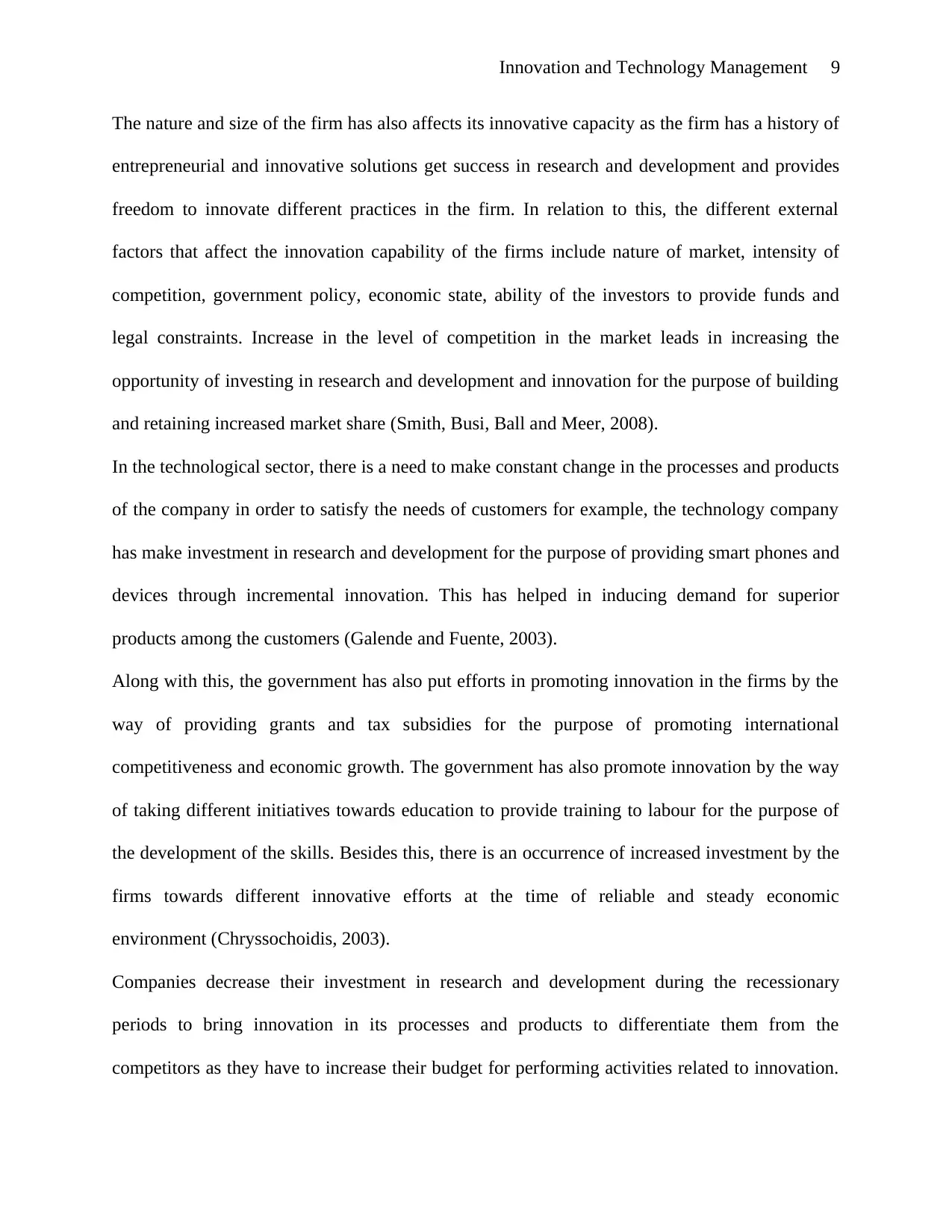
Innovation and Technology Management 9
The nature and size of the firm has also affects its innovative capacity as the firm has a history of
entrepreneurial and innovative solutions get success in research and development and provides
freedom to innovate different practices in the firm. In relation to this, the different external
factors that affect the innovation capability of the firms include nature of market, intensity of
competition, government policy, economic state, ability of the investors to provide funds and
legal constraints. Increase in the level of competition in the market leads in increasing the
opportunity of investing in research and development and innovation for the purpose of building
and retaining increased market share (Smith, Busi, Ball and Meer, 2008).
In the technological sector, there is a need to make constant change in the processes and products
of the company in order to satisfy the needs of customers for example, the technology company
has make investment in research and development for the purpose of providing smart phones and
devices through incremental innovation. This has helped in inducing demand for superior
products among the customers (Galende and Fuente, 2003).
Along with this, the government has also put efforts in promoting innovation in the firms by the
way of providing grants and tax subsidies for the purpose of promoting international
competitiveness and economic growth. The government has also promote innovation by the way
of taking different initiatives towards education to provide training to labour for the purpose of
the development of the skills. Besides this, there is an occurrence of increased investment by the
firms towards different innovative efforts at the time of reliable and steady economic
environment (Chryssochoidis, 2003).
Companies decrease their investment in research and development during the recessionary
periods to bring innovation in its processes and products to differentiate them from the
competitors as they have to increase their budget for performing activities related to innovation.
The nature and size of the firm has also affects its innovative capacity as the firm has a history of
entrepreneurial and innovative solutions get success in research and development and provides
freedom to innovate different practices in the firm. In relation to this, the different external
factors that affect the innovation capability of the firms include nature of market, intensity of
competition, government policy, economic state, ability of the investors to provide funds and
legal constraints. Increase in the level of competition in the market leads in increasing the
opportunity of investing in research and development and innovation for the purpose of building
and retaining increased market share (Smith, Busi, Ball and Meer, 2008).
In the technological sector, there is a need to make constant change in the processes and products
of the company in order to satisfy the needs of customers for example, the technology company
has make investment in research and development for the purpose of providing smart phones and
devices through incremental innovation. This has helped in inducing demand for superior
products among the customers (Galende and Fuente, 2003).
Along with this, the government has also put efforts in promoting innovation in the firms by the
way of providing grants and tax subsidies for the purpose of promoting international
competitiveness and economic growth. The government has also promote innovation by the way
of taking different initiatives towards education to provide training to labour for the purpose of
the development of the skills. Besides this, there is an occurrence of increased investment by the
firms towards different innovative efforts at the time of reliable and steady economic
environment (Chryssochoidis, 2003).
Companies decrease their investment in research and development during the recessionary
periods to bring innovation in its processes and products to differentiate them from the
competitors as they have to increase their budget for performing activities related to innovation.
⊘ This is a preview!⊘
Do you want full access?
Subscribe today to unlock all pages.

Trusted by 1+ million students worldwide
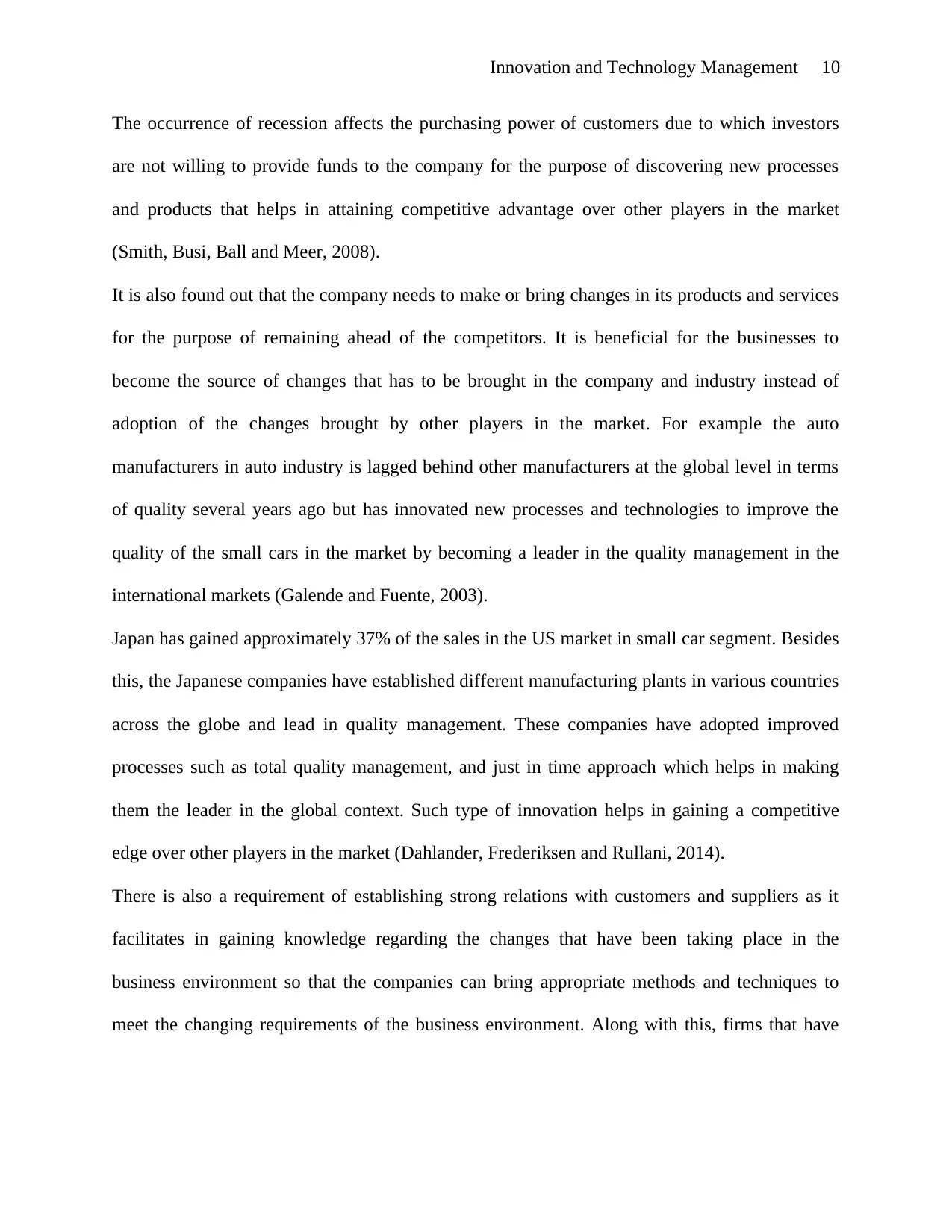
Innovation and Technology Management 10
The occurrence of recession affects the purchasing power of customers due to which investors
are not willing to provide funds to the company for the purpose of discovering new processes
and products that helps in attaining competitive advantage over other players in the market
(Smith, Busi, Ball and Meer, 2008).
It is also found out that the company needs to make or bring changes in its products and services
for the purpose of remaining ahead of the competitors. It is beneficial for the businesses to
become the source of changes that has to be brought in the company and industry instead of
adoption of the changes brought by other players in the market. For example the auto
manufacturers in auto industry is lagged behind other manufacturers at the global level in terms
of quality several years ago but has innovated new processes and technologies to improve the
quality of the small cars in the market by becoming a leader in the quality management in the
international markets (Galende and Fuente, 2003).
Japan has gained approximately 37% of the sales in the US market in small car segment. Besides
this, the Japanese companies have established different manufacturing plants in various countries
across the globe and lead in quality management. These companies have adopted improved
processes such as total quality management, and just in time approach which helps in making
them the leader in the global context. Such type of innovation helps in gaining a competitive
edge over other players in the market (Dahlander, Frederiksen and Rullani, 2014).
There is also a requirement of establishing strong relations with customers and suppliers as it
facilitates in gaining knowledge regarding the changes that have been taking place in the
business environment so that the companies can bring appropriate methods and techniques to
meet the changing requirements of the business environment. Along with this, firms that have
The occurrence of recession affects the purchasing power of customers due to which investors
are not willing to provide funds to the company for the purpose of discovering new processes
and products that helps in attaining competitive advantage over other players in the market
(Smith, Busi, Ball and Meer, 2008).
It is also found out that the company needs to make or bring changes in its products and services
for the purpose of remaining ahead of the competitors. It is beneficial for the businesses to
become the source of changes that has to be brought in the company and industry instead of
adoption of the changes brought by other players in the market. For example the auto
manufacturers in auto industry is lagged behind other manufacturers at the global level in terms
of quality several years ago but has innovated new processes and technologies to improve the
quality of the small cars in the market by becoming a leader in the quality management in the
international markets (Galende and Fuente, 2003).
Japan has gained approximately 37% of the sales in the US market in small car segment. Besides
this, the Japanese companies have established different manufacturing plants in various countries
across the globe and lead in quality management. These companies have adopted improved
processes such as total quality management, and just in time approach which helps in making
them the leader in the global context. Such type of innovation helps in gaining a competitive
edge over other players in the market (Dahlander, Frederiksen and Rullani, 2014).
There is also a requirement of establishing strong relations with customers and suppliers as it
facilitates in gaining knowledge regarding the changes that have been taking place in the
business environment so that the companies can bring appropriate methods and techniques to
meet the changing requirements of the business environment. Along with this, firms that have
Paraphrase This Document
Need a fresh take? Get an instant paraphrase of this document with our AI Paraphraser
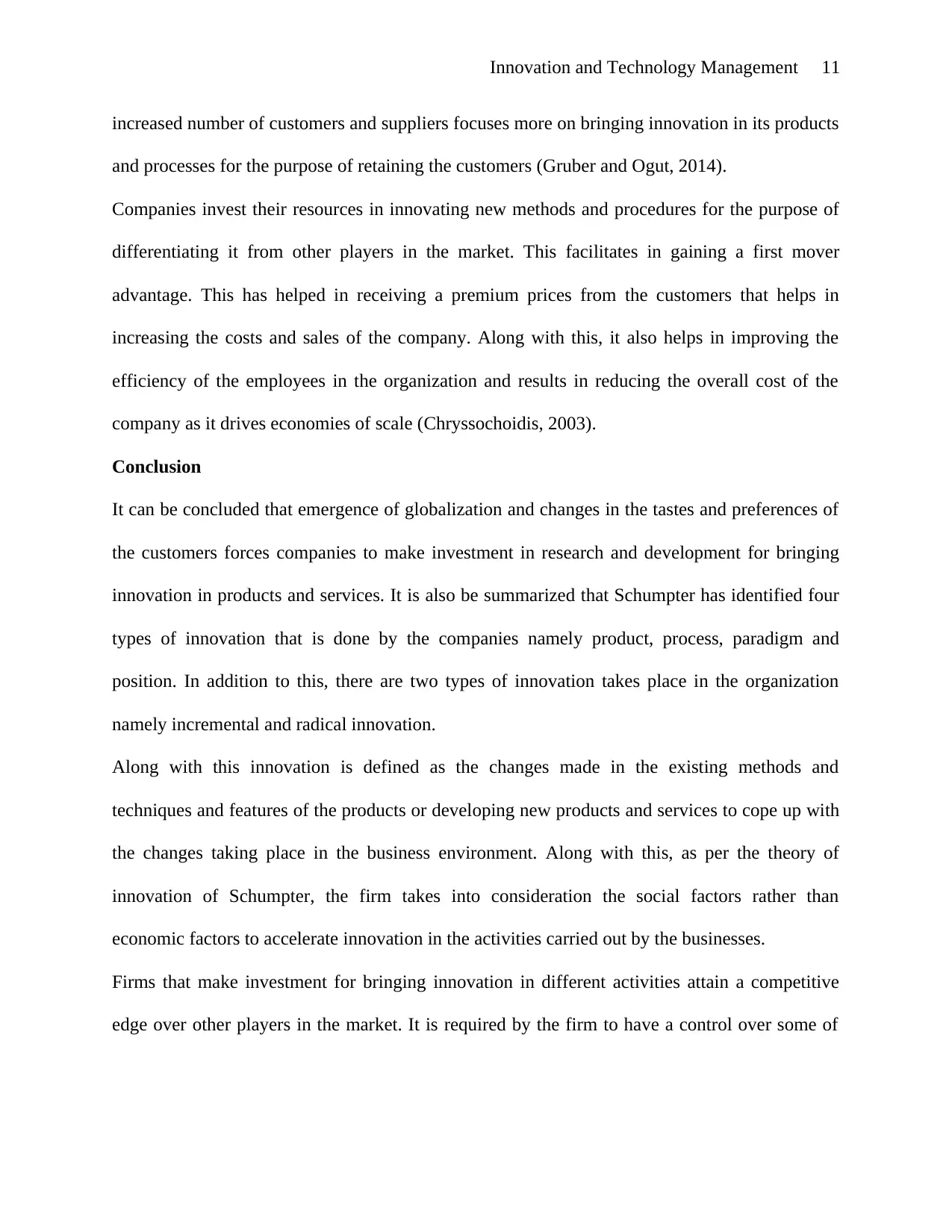
Innovation and Technology Management 11
increased number of customers and suppliers focuses more on bringing innovation in its products
and processes for the purpose of retaining the customers (Gruber and Ogut, 2014).
Companies invest their resources in innovating new methods and procedures for the purpose of
differentiating it from other players in the market. This facilitates in gaining a first mover
advantage. This has helped in receiving a premium prices from the customers that helps in
increasing the costs and sales of the company. Along with this, it also helps in improving the
efficiency of the employees in the organization and results in reducing the overall cost of the
company as it drives economies of scale (Chryssochoidis, 2003).
Conclusion
It can be concluded that emergence of globalization and changes in the tastes and preferences of
the customers forces companies to make investment in research and development for bringing
innovation in products and services. It is also be summarized that Schumpter has identified four
types of innovation that is done by the companies namely product, process, paradigm and
position. In addition to this, there are two types of innovation takes place in the organization
namely incremental and radical innovation.
Along with this innovation is defined as the changes made in the existing methods and
techniques and features of the products or developing new products and services to cope up with
the changes taking place in the business environment. Along with this, as per the theory of
innovation of Schumpter, the firm takes into consideration the social factors rather than
economic factors to accelerate innovation in the activities carried out by the businesses.
Firms that make investment for bringing innovation in different activities attain a competitive
edge over other players in the market. It is required by the firm to have a control over some of
increased number of customers and suppliers focuses more on bringing innovation in its products
and processes for the purpose of retaining the customers (Gruber and Ogut, 2014).
Companies invest their resources in innovating new methods and procedures for the purpose of
differentiating it from other players in the market. This facilitates in gaining a first mover
advantage. This has helped in receiving a premium prices from the customers that helps in
increasing the costs and sales of the company. Along with this, it also helps in improving the
efficiency of the employees in the organization and results in reducing the overall cost of the
company as it drives economies of scale (Chryssochoidis, 2003).
Conclusion
It can be concluded that emergence of globalization and changes in the tastes and preferences of
the customers forces companies to make investment in research and development for bringing
innovation in products and services. It is also be summarized that Schumpter has identified four
types of innovation that is done by the companies namely product, process, paradigm and
position. In addition to this, there are two types of innovation takes place in the organization
namely incremental and radical innovation.
Along with this innovation is defined as the changes made in the existing methods and
techniques and features of the products or developing new products and services to cope up with
the changes taking place in the business environment. Along with this, as per the theory of
innovation of Schumpter, the firm takes into consideration the social factors rather than
economic factors to accelerate innovation in the activities carried out by the businesses.
Firms that make investment for bringing innovation in different activities attain a competitive
edge over other players in the market. It is required by the firm to have a control over some of
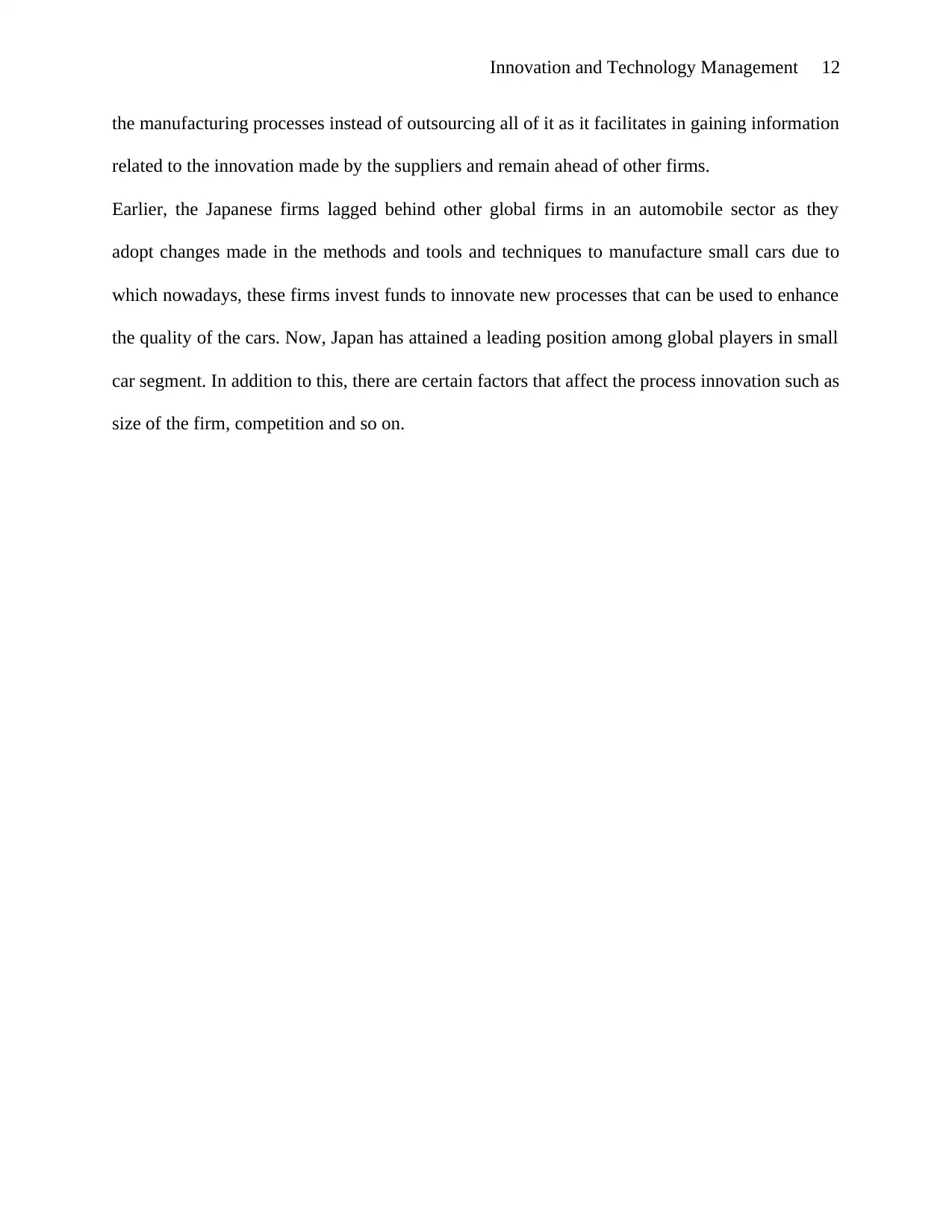
Innovation and Technology Management 12
the manufacturing processes instead of outsourcing all of it as it facilitates in gaining information
related to the innovation made by the suppliers and remain ahead of other firms.
Earlier, the Japanese firms lagged behind other global firms in an automobile sector as they
adopt changes made in the methods and tools and techniques to manufacture small cars due to
which nowadays, these firms invest funds to innovate new processes that can be used to enhance
the quality of the cars. Now, Japan has attained a leading position among global players in small
car segment. In addition to this, there are certain factors that affect the process innovation such as
size of the firm, competition and so on.
the manufacturing processes instead of outsourcing all of it as it facilitates in gaining information
related to the innovation made by the suppliers and remain ahead of other firms.
Earlier, the Japanese firms lagged behind other global firms in an automobile sector as they
adopt changes made in the methods and tools and techniques to manufacture small cars due to
which nowadays, these firms invest funds to innovate new processes that can be used to enhance
the quality of the cars. Now, Japan has attained a leading position among global players in small
car segment. In addition to this, there are certain factors that affect the process innovation such as
size of the firm, competition and so on.
⊘ This is a preview!⊘
Do you want full access?
Subscribe today to unlock all pages.

Trusted by 1+ million students worldwide
1 out of 15
Related Documents
Your All-in-One AI-Powered Toolkit for Academic Success.
+13062052269
info@desklib.com
Available 24*7 on WhatsApp / Email
![[object Object]](/_next/static/media/star-bottom.7253800d.svg)
Unlock your academic potential
Copyright © 2020–2025 A2Z Services. All Rights Reserved. Developed and managed by ZUCOL.





